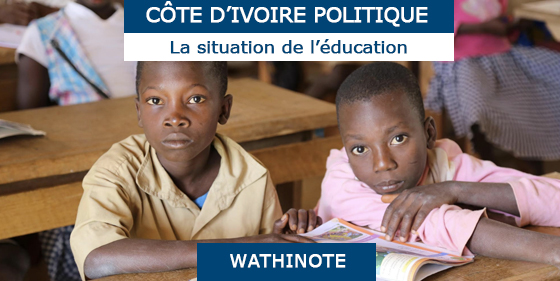Author: Ehouman Williams Venance AHOUAKAN
Affiliated organization: Université Jean Lorougnon Guede
Type of publication: Research article
Date of publication: 2022
*Wathinotes are excerpts from publications chosen by WATHI and conform to the original documents. The reports used for the development of the Wathinotes are selected by WATHI based on their relevance to the country context. All Wathinotes refer to original and integral publications that are not hosted by the WATHI website, and are intended to promote the reading of these documents, which are the result of the research work of academics and experts.
Descriptive statistics
On average, children in the sample are aged 10.73 years and that 52.83% are males. A total of 31.86% were engaged in economic activities, while 69.83% were provided with schooling. Households in the sample have an average size of 8 individuals and reside for most of half of them in rural areas (53.09%). They are usually led by males (80.23%). Household heads are on average 46 years old and have low levels of education. At the national level, the private return to education stood at 6.20% on average under the period 2008 to 2013, while the rate of unemployment was estimated at 4.11% on average under the same period.
Child labour
The estimation results generally indicate that an improvement in the private return to education is associated with a decrease in children’s involvement in economic activities. Both the return to education in households’ region of residence and those in the other regions are relevant to explain their behaviours concerning child labour options, confirming that previous studies might have underestimated the influence of this variable on child labour decisions. In general, an improvement in the private return to education has, in absolute terms, a greater impact on girls’ likelihood of being removed from economic activities compared to boys.
Schooling
Globally, a marginal increase in the private return to education is associated with a greater participation of children in school activities. Although we found little evidence that improvement in the returns to education turn into a sharp improvement in school attendance for boys, it is worthwhile to keep in mind that boys’ withdrawal from economic activities due to better expected returns to education could reflect households’ will to allow children already enrolled in the educational system, especially those combining both schooling and labour to devote more time to their studies.
In general, an improvement in the private return to education has, in absolute terms, a greater impact on girls’ likelihood of being removed from economic activities compared to boys
In the same vein, although children’s enrolment rate is low at the national level (approximately 70%), the weak impact of the improvement of the expected return to education on schooling could also be partly because many children among those working only or those doing nothing currently are considered by parents too old to begin attending school now. Children who revealed being involved only in economic activities are, for example, on average, older than children in the sample (12,13 years compared with 10,73 years for the whole sample). We find therefore that the effects of an improvement in the return to education on schooling and child labour decisions may potentially be non-symmetrical.
Conclusion and policy recommendations
The results confirm, albeit partially, the intuitions we had before conducting the study. Indeed, we find evidence that households consider both the information they hold about the expected return to education in their region of residence and those from the other regions of the country when deciding to involve children in labour. However, we find little evidence that returns to education are relevant to explaining their decisions to provide boys with schooling.
Globally, a marginal increase in the private return to education is associated with a greater participation of children in school activities
Since improvement in the return to education is globally associated with a regression in children’s involvement in labour and an improvement in girls’ participation in school activities, sound educational system and labour market reforms likely to improve the return to education in the country could help reduce, naturally, child labour and the educational gap between girls and boys, which remains large at both primary, secondary and tertiary education levels. The results also shed light on the necessity to design specific educational programs for older children.


Commenter